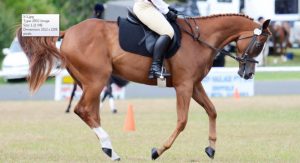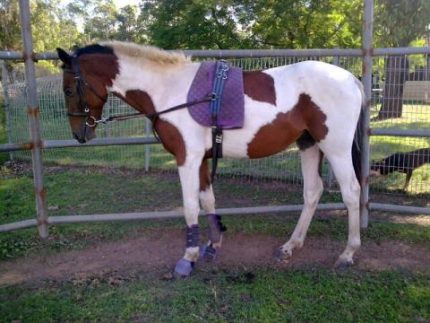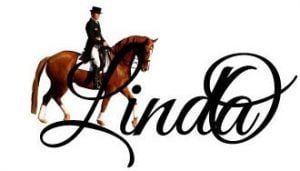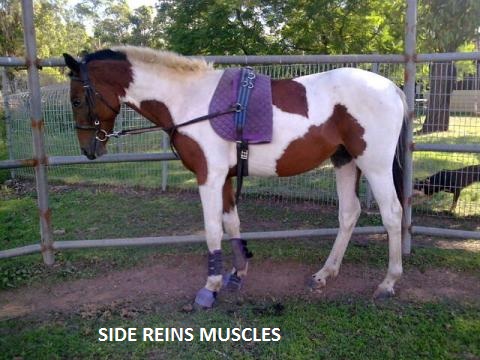The damage caused by side reins with the Horse occurs in all Horses BELOW established Elementary Standard. After that, it matters not for they know about ‘Collection’
A LETTER (25,000 and counting)
Hi
I am hoping that you can help me. I have a lovely little Arabian who has been under saddle for 12 months he is rising 5. His natural head carriage is quite arched. He works lovely under saddle but has the tendency to over bend. Everyone has said take up the contact and push him forward, problem being he is forward and the more you push the more he over bends he even does this on a long rein. He tracks up nicely and is soft through his back. If you take up to much contact he chucks a lama neck and tosses the head around, there must be a simple solution to this.
thanks in anticipation
Sharon
and…..
Hello,
I’d like to know what you think of the picture of the horse attached to this email. To me his neck muscles seem quite under-developed.
Do you have any suggestions on how to build up these muscles? He’s not my horse, but I am thinking of purchasing. Would working him in a “long and low” frame help build his top line? and what causes his neck to look this way?
Thank you for any advice you can offer!
Kate

Yes, another regular problem caused by Side Reins on ‘young, green or formative’ horses.’
THE BASIS OF MY ARGUMENT
I read Equestrian Forums a lot. They often argue the for and against of the use of side reins and other artificial aids. They never agree and they will never agree. Depends on which side of the Industry you come from. I have never really got into these debates as it would be rare to find anyone who has ridden the cross section of horses and felt their mouths. They are therefore not qualified to debate the matter imho.
I am simply sounding the warning that
side reins damage the mouths of young, green, inexperienced and newly broken in horses.
They do not however, affect horses that are established in collection. My wife uses them on all of her established Dressage horses and I have never witnessed any harm. I have however, just this week, had a feel of the mouths of her two younger ones (Novice Dressage Level) and have found diminished mouths and an increased ignorance and resistance, caused once again, by Side Reins.
The use of side reins as an artificial aid in training is a widely accepted thing. I have no problems with that but I do have some warnings, based upon the twenty or so ruined horses that are sent to me each year, caused directly by the use of side reins.
I rate the mouth on a horse on a scale of zero to ten. Zero being an untouched, unbroken horse. Some of those horses had mouths that were minus zero. Over the years, as with everything, I have observed and experimented. I have arrived at the following ‘Golden Rule’ when it comes to the use of them.
That the use of side reins, when used on horses below established Elementary Dressage, causes varying degrees of damage to their mouths, diminishes the possible rating of the finished mouth and totally destroys others. Above Elementary Dressage level, I have no quarrel with their use but would still carefully observe how the horse is using them, their adjustment at all times and the adjustment of them.
For the newly broken in horse, the green horse or the inexperienced owner, I strongly warn against them. Here are some reasons:
- As a horse goes around, one rarely has a complete idea of just how hard a horse is baring down upon them or pulling against them.
- They are too fixed, allow a horse very little room to maneuver and to possibly find any real relief, which after all is that training gem that we are looking for during the training of the young horse.
- They do not allow a young horse enough freedom, enough relief, enough flexion each way and above all, the room to travel ‘long and low’ should the horse so wish. If they do, because of the lack of Dressage foundation that horses of this level have, they don’t know how to travel low without going drastically behind the bit. A dangerous thing for them to learn early on.
- If you agree with the ‘German Training Scale’ you may agree with the fact that young Horses need to be going around in young horse mode and frame, to be able to use their back, to be progressively built up into athletes to be able to ‘collect’. Side Reins instantly Jam them into a limited frame which does not suit most.
- Young horses should be prepared and assisted in the un-natural task of carrying an un-balanced rider. To do this, especially at the young or ‘green’ age, surely horses should be worked ‘long and low’? Side reins do not allow or promote this and inevitably, no matter how hard the horse tries to search for the low contact, it runs into a brick wall. That causes it to come ‘behind the Bit’ and to not take a ‘contact’.
RUBBER BANDS
The Logic of these are against all training theories and in fact, they only ruin Mouths, teach resistance and have a negative impact upon Muscle development
Every week, I meet new horses that have been played around with by their owners who could just not wait for the Breaker. They put side reins on……real loose or with big rubber bands in them so there is no damage as they attempt to do the right thing. I can tell you that 100% of them have reduced mouths and can never end as good as the un-touched mouth.
Long side reins and side reins with rubber bands in them commence the first teaching of a young horse how to resist and evade or worse, begin to be a ‘head bobber’. Just like when there is a rider on them who ‘jiggles’. To learn how NOT to get a ‘head set’
Damage can be done quickly. I once worked on a 17 hand high 3 year old Warmblood named “Davidson”, who was impossible to stop for a seasoned professional rider. This damage had been done in around 7 days by a Show Jumping Trainer using Side Reins and had been attempting to stop a buck jumping problem with the horse. The horse went on to be a successful Eventer at high level and was ridden by Scott Keach. I once refunded $10,000 to a Buyer and ‘Dogged’ a pure bred warmblood because one side rein experience conducted by a Perth Level 3 Coach, turned the Horse into a ‘Bolter’
So, if the horse is young or ‘Green‘, stay right away from side reins. What are the alternatives then?
THE GERMAN TRAINING SCALE
To follow it’s Internationally proven benefits, it is said that young horses need to learn to stretch, follow a feel, look for the bit, learn to go ‘long and low’, ‘over the back and all of the other good things to set the foundation stones. Side Reins allow none of this imho.
RUNNING REINS
I have never had a problem caused by the use of running reins and I have used them thousands of times. On young horses and particularly old seasoned horses with worn out mouths or giant upside down necks. Typical of 95% of Pony Club Horses in Australia
Running reins are reins made from anything from leather to twine that run from the centre of the girth between the front legs of a horse, between the front legs or outside of them to and through the ring on each side of the bit and then to a fixed point on the top of the wither, roller or saddle..
Lunged with Side Reins

And after with running reins
THE DANGERS OF INCORRECT ADJUSTMENT
When introducing artificial aids of any description, there is a high risk of injury or death to the horse. Each year in Australia, a horse somewhere, dies due to instillation of incorrectly fitted equipment on horses. The rule is therefore, that we must start with such equipment being loose and gradually tightening the adjustments when and only if you see the horse completely understanding what you want and that the horse is giving to the pressure applied. Both of these points are interconnected and highly important. You must be sure that the horse has got the message what is required, such as bobbing it’s head and breaking at the poll, before ever adjusting reins up tighter.
Prior to rearing because of tight equipment, a horse will slow, come to a halt and start to step back. These are the signs that the handler must recognize and do so at the speed of light, for the safety and well being of your horse depends upon your re-action. To protect your horse under such circumstances, you must leap to a position where you are behind your horse and quite simply, cane, whack or what ever other description you want use, the horse’s rump. It must be sent forward and any force is reasonable under these circumstances. The horse that goes forward does not rear and is therefore safe from injury. If this has happened once, they rarely do it again, only if the owner is a ‘super goose’ and adjusts up too soon again.
I hear the argument that “We only have them done up loose. Well that is a waste of time for a start and teaching the horse a little bit of resistance and a little bit of contact but not enough of anything. This builds the ‘upside down neck’
OTHER GIMMICKS
Pessoa’s, Chambons and all of the other contraptions give no added benefits over Running Reins and I have carefully examined and used them all on an experimental basis. Smart packaging and Sales key words. Here is Holland’s No. 1 Lunge Trainer at the Dutch Equitana
THE CRUX OF MY ARGUMENT
I have found that side reins put on young or inexperienced horses, below about Elementary Dressage level, damaged every horse that I have ever ridden. No exceptions. That damage has been in varying degrees and on some of them, many other people would not identify damage. I do and the reason is that I often feel good mouths and have always got that benchmark to test against. Most people have not. I have never experienced or felt damage done by the use of Running Reins.
HP’s RUNNING REINS SYSTEM
In order to obtain a more flexible running reins system that can be found in the Saddle Shops, I have designed my own and that provides for 5 different ways to lunge a Horse and allows me to cater for the varying problems that I meet:
- The differing conformation of Horses.
- The differing Veterinary challenges of Horses.
- The rehabilitation of aged Horses.
- Whether Horses are ‘upwardly mobile in the mind’ or not
- Too ‘on the forehand
and more.
These are the many reasons why side reins or put your horse in a box, does not have the flexibility of training.
Our RUNNING REINS SYSTEM, Comes with an 44 Page E-Book of how to rehabilitate Horses with Rear end Veterinary Problems if they are such that they can be rectified.
Hi Mr and Mrs HP,
Your training methods have helped me and my young pinto so very much that I wanted to send you a few photos.
I have had my 4yr old gelding for 7 months now, bought last winter, for a pittance ($700) from a young girl who had been in a terrible car accident and could not ride anymore.
The second pic (27062010147) is the day I brought him home looking pretty much worse for wear i.e. like a donkey! after being put out for more than 6 months and not handled at all.
Prior to that he had only had a few months riding after being broken – I have no idea how he was broken or by whom.
I just wanted to send them and let u know that your methods work and this is proof – only 7 months work once a week has produced a fantastic result and anyone can do it!!!! :
From the last few pics you can see how happy me and my pony are and its all thanks to watching your DVDs and reading your stories.
Am so looking forward to your NSW workshop in Wagga Wagga!!
P.S. my pony was the one with the “Pigroot Button” that I emailed you about last year. Got that sorted too!!
Kind Regards,
Sarah
Before
After
Regards

Listen to Your Horses

